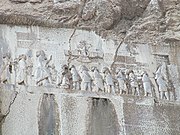Indabibi
Indabibi est un dirigeant de l'ancienne Élam en 649 av. J.-C.[1] et peut-être 648[2]. Il est parfois appelé Indabigash.[3] Il est fut le successeur de Tammaritu II et le prédécesseur de Humban-Haltash III. L'Élam était situé à l'est du puissant Empire assyrien, et le règne d'Indabibi a eu lieu sous le règne du roi assyrien Assurbanipal (668 - 617).
En 649, le roi élamite Tammaritu II est déposé dans un soulèvement et s'enfuit vers le roi d'Assyrie Assurbanipal, à ce moment-là Indabibi prit le trône. En effet, Assurbanipal était engagé dans un conflit avec son frère, Shamash-shum-ukin, roi de Babylone, qui tentait de prendre le contrôle de l'Empire Assyrien. Tammaritu II soutenait militairement Shamash-shum-ukin[4]. Au cours d'une bataille, Indabibi, qui était général élamite, changea de camp et Tammaritu II se réfugia à Ninive en 650 ou 649.
Les annales assyriennes indiquent des rapports contradictoires sur la relation d'Indabibi avec l'Assyrie : une source, écrite pendant le règne d'Indabibi, rapporte qu'Indabibi était un allié et un "frère" d'Assurbanipal, tandis qu'une source écrite deux ans plus tard a une opinion différente[5].
Au fur et à mesure que les relations se détériorent, Assurbanipal demande à Indabibi d'extrader vers lui un certain nombre de sujets rebelles qui se réfugiaient à Élam[6]. Indabibi en a livré quelques-uns, mais en a refusé d'autres[6]. Assurbanipal a renvoyé un messager pour demander l'extradition des sujets restants, mais le message n'a jamais atteint Élam[6].
Les Annales d'Assurbanipal rapportent qu'Assurbanipal a déclaré être contre Indabibi[7]. Alors que les armées d'Assurbanipal approchaient d'Élam, les Élamites se révoltèrent et tuèrent Indabibi en 648[8],[6].
Indabibi a été ensuite remplacé par Humban-haltash III[9].
Voir aussi[modifier | modifier le code]
Références[modifier | modifier le code]
- (en) Cet article est partiellement ou en totalité issu de l’article de Wikipédia en anglais intitulé « Indabibi » (voir la liste des auteurs).
- Jane McIntosh, Ancient Mesopotamia : New Perspectives, ABC-CLIO, , 395 p. (ISBN 978-1-57607-965-2, lire en ligne), p. 359
- His reign is listed as occurring entirely in 649 by McIntosh. On the other hand, Elizabeth Carter and Matthew Stolper see his reign as extending into 648. Jane McIntosh, Ancient Mesopotamia : New Perspectives, ABC-CLIO, , 395 p. (ISBN 978-1-57607-965-2, lire en ligne), p. 359 Elizabeth Carter et Matthew W. Stolper, Elam : Surveys of Political History and Archaeology, University of California Press, , 328 p. (ISBN 978-0-520-09950-0, lire en ligne), p. 51
- Elizabeth Carter et Matthew W. Stolper, Elam : Surveys of Political History and Archaeology, University of California Press, , 328 p. (ISBN 978-0-520-09950-0, lire en ligne), p. 51
- D. T. Potts (1999). The Archaeology of Elam: Formation and Transformation of an Ancient Iranian State. p. 282.
- Marvin Alan Sweeney et Ehud Ben Zvi, The Changing Face of Form Criticism for the Twenty-first Century, Wm. B. Eerdmans Publishing, (ISBN 978-0-8028-6067-5, lire en ligne), p. 141
- D. T. Potts, The Archaeology of Elam : Formation and Transformation of an Ancient Iranian State, Cambridge University Press, (ISBN 978-1-316-58631-0, lire en ligne), p. 458
- (en) Amnon Altman, Tracing the Earliest Recorded Concepts of International Law : The Ancient Near East (2500-330 BCE), Leiden/Boston, BRILL, , 254 p. (ISBN 978-90-04-22252-6 et 90-04-22252-9, lire en ligne), p. 169
- Marvin Alan Sweeney et Ehud Ben Zvi, The Changing Face of Form Criticism for the Twenty-first Century, Wm. B. Eerdmans Publishing, , 141 p. (ISBN 978-0-8028-6067-5, lire en ligne)
- Elizabeth Carter and Matthew W. Stolper (1984). Elam: Surveys of Political History and Archaeology. p. 50.

